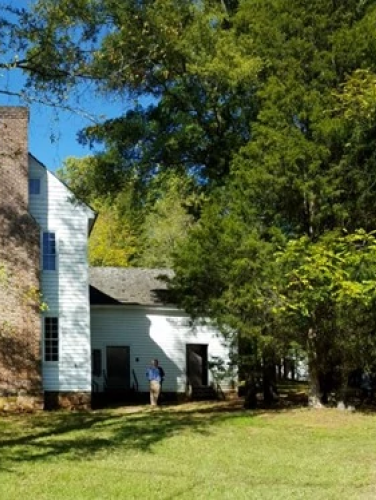
Hugh Torance House and Store
(ca. lates 1770s)
The Torance House and Store was the first Mecklenburg County residence of the family that later owned Cedar Grove, the county’s largest plantation.
8231 Gilead Road Road, Huntersville, NC 28078
The Hugh Torance House and Store, built at some point between 1780 and the early 1800s, is one of the few houses to survive from the eighteenth century settlement period of Mecklenburg County. Hugh Torance (1743-1816; also spelled Torrance and Torrence) emigrated to the American colonies from Ireland with his brother Albert around 1763. It is believed that the brothers came as indentured servants. Hugh lived in Pennsylvania for several years prior to the outbreak of the American Revolutionary War. After taking an oath of allegiance to the Pennsylvania General Assembly, Hugh joined the revolutionary forces and fought in North Carolina with the "Partisan Chargers," a light cavalry company led by Captain Galbraith Falls who was killed on June 20, 1780, at the Battle of Ramsour's Mill in Lincoln County, North Carolina. Records show that Hugh was a disbursing agent for Falls' militia and probably stayed in the army until 1781.
Property Quick Links
After the war, Hugh married Captain Falls' widow, Isabella Kerr Falls (1740-1816) in 1783. He, Isabella, and her eight children lived briefly in Rowan County where Hugh operated a store. They had one child together, James Galbraith Torrence (1784-1847). The family moved to Mecklenburg County to occupy the Torance House and Store some time in the 1770s, as indicated by local land records. In 1779, Hugh purchased 667 acres of land. By the 1790s, he had purchased more than 500 additional acres. At the time of his death in 1816, Hugh had accumulated over 1,400 acres of land.
No available records suggest that Hugh owned any enslaved people prior to his marriage, but he did purchase from the estate of Isabella’s deceased husband five enslaved African Americans: Phill, Binah, Ned, Nell, and Phoebe. The ages and possible family relationships among those five individuals remain unclear. In 1816, when the February deaths of both Hugh and Isabella prompted an inventory of their possessions, only Phill, Ned, and Nell were still identified enslaved persons owned by the couple. As Hugh’s land holdings grew, so too did his reliance upon enslaved labor. Upon his death, Hugh owned thirty-three enslaved people. His son James thereafter substantially expanded the family’s agricultural operations, doubling the acreage and tripling the enslaved population that worked and lived on what later became Cedar Grove, the county’s largest planation.
The Torance House and Store was the first of two structures Hugh built to accommodate his family. The original one-room log house, now occupying the northern section of the building, was later divided into two rooms: a parlor (located in the northwest corner) and the store extending to the east. Prior to the 1805 opening of the store, a small storage room was added to the east end of the house. Final construction in 1796 added a two-story wood frame house to the south side of the parlor, giving the house its L- shaped layout. A second house of brick was later constructed on the adjacent site now occupied by the Cedar Grove house.

